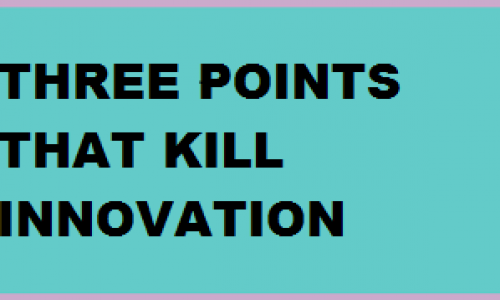While most of us in an organisation try to be innovative, in reality we actually kill innovation unintentionally.
An article in ccl.org lists out a few points how innovation is killed.
The first on the list is the feasibility trap.
While most organisations claim that they want to deliver what the customer wants, what they end up doing is what they can.
Research suggests that this the fault of managers as they get in the feasibility trap.
Researchers found that when managers look at new ideas, they look for the most feasible ideas as their measure of desirability. Yet when customers look for new ideas, their measure of desirability is creativity.
It is not the lack of big ideas, but what happens to those ideas.
Being feasible has also one more drawback as customers feel them to be less creative.
Researchers note, 'In other words, creativity isn’t being seen by customers as the icing on the cake; it is the cake.'
If your investment is small, your return is bigger. Yet since your customers are looking for truly innovative ideas, and since truly innovative ideas mean 'thinking and doing different,' that means that metrics for viability are difficult to come by.
The next point which kills creativity is 'How'. This problem occurs when ideas have to be cleared by evaluators who have a 'How' mindset.
Thinking about the purpose of the innovation or 'for what reason does it exist' helps to focus attention on what customers want, rather than how can the enterprise produce it.
As author Simon Sinek says, 'People don’t buy what you do, they buy why you do it.'
Mueller, Loewenstein and Deal note 'concerns about feasibility make creative ideas harder for (managers) to stomach. But some managers excel at avoiding these concerns.'
Research suggests an inverse relationship between feasibility and creativity, and since for customers, creativity predicts desirability, the challenge for managers is to look for ideas that are first creative, and then shift the focus to how to make them work.
The mindset of 'how' limits innovation, so instead of thinking about 'how', first create the wild idea and then think how to make it work.
The third point obstructing creativity is what people to be an creative idea.
A person’s culture, mindset, role, and personality all affect the very cues people use to determine what is creative.
What’s creative to you is different than what is creative to me, if we work in different groups or come from a different perspective.
'From a process point of view, that means all decision-makers need to be working from a common set of evaluation criteria. Managers need to be explicit about how an idea will be evaluated, what metrics will be used, and how committed the organisation is to creating core, adjacent, or transformational innovation,' the researchers say.
The possible solution is to come to an agreement as to what an desirable innovation is.
The researchers note that, 'Managers need to be aware of the differences in perception by people in different groups. They also need to be aware that some environments may put people in mindsets which make certain cues more salient and important.'



